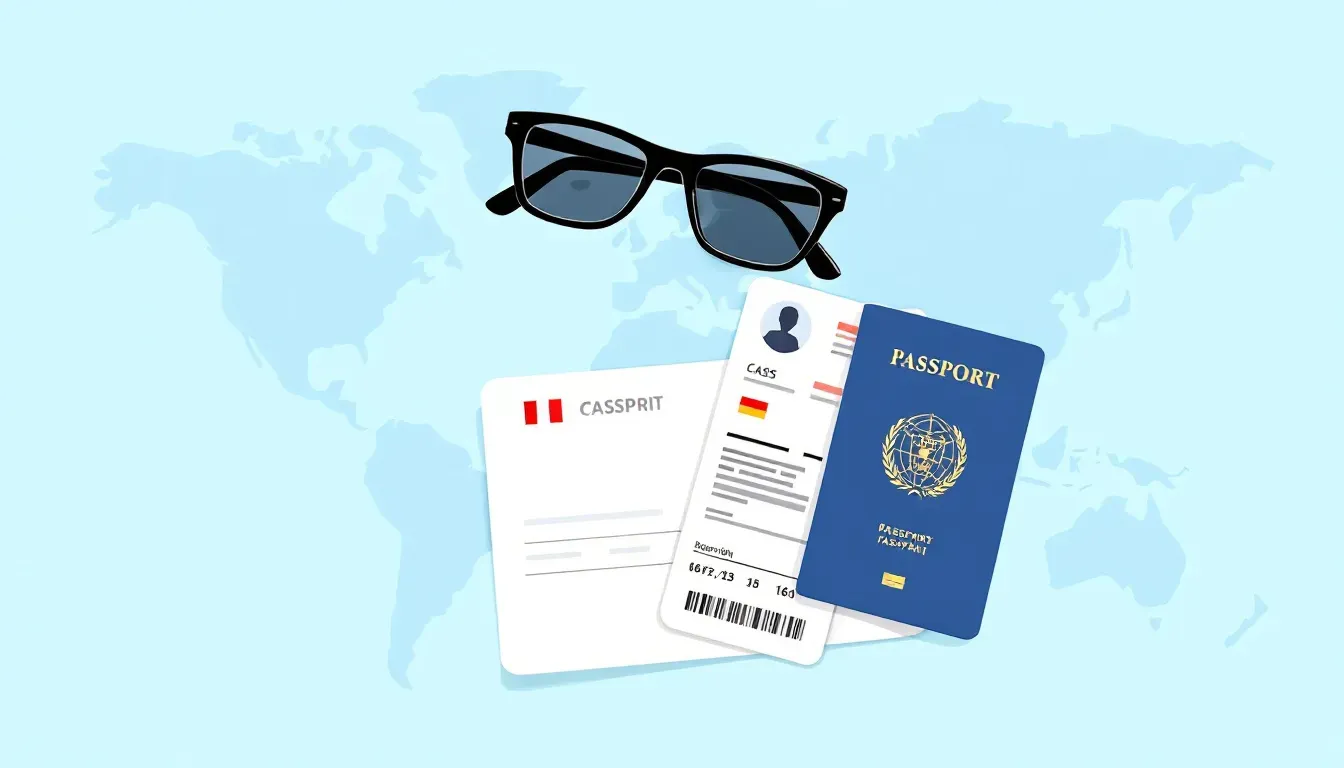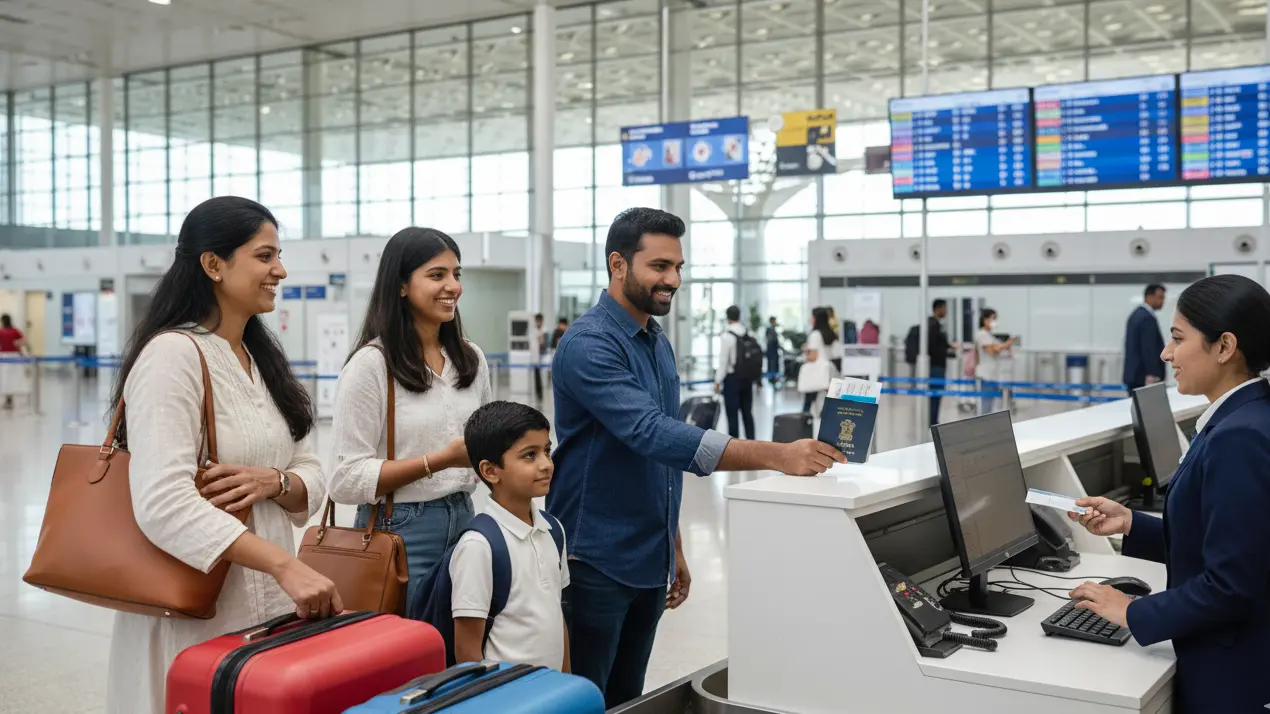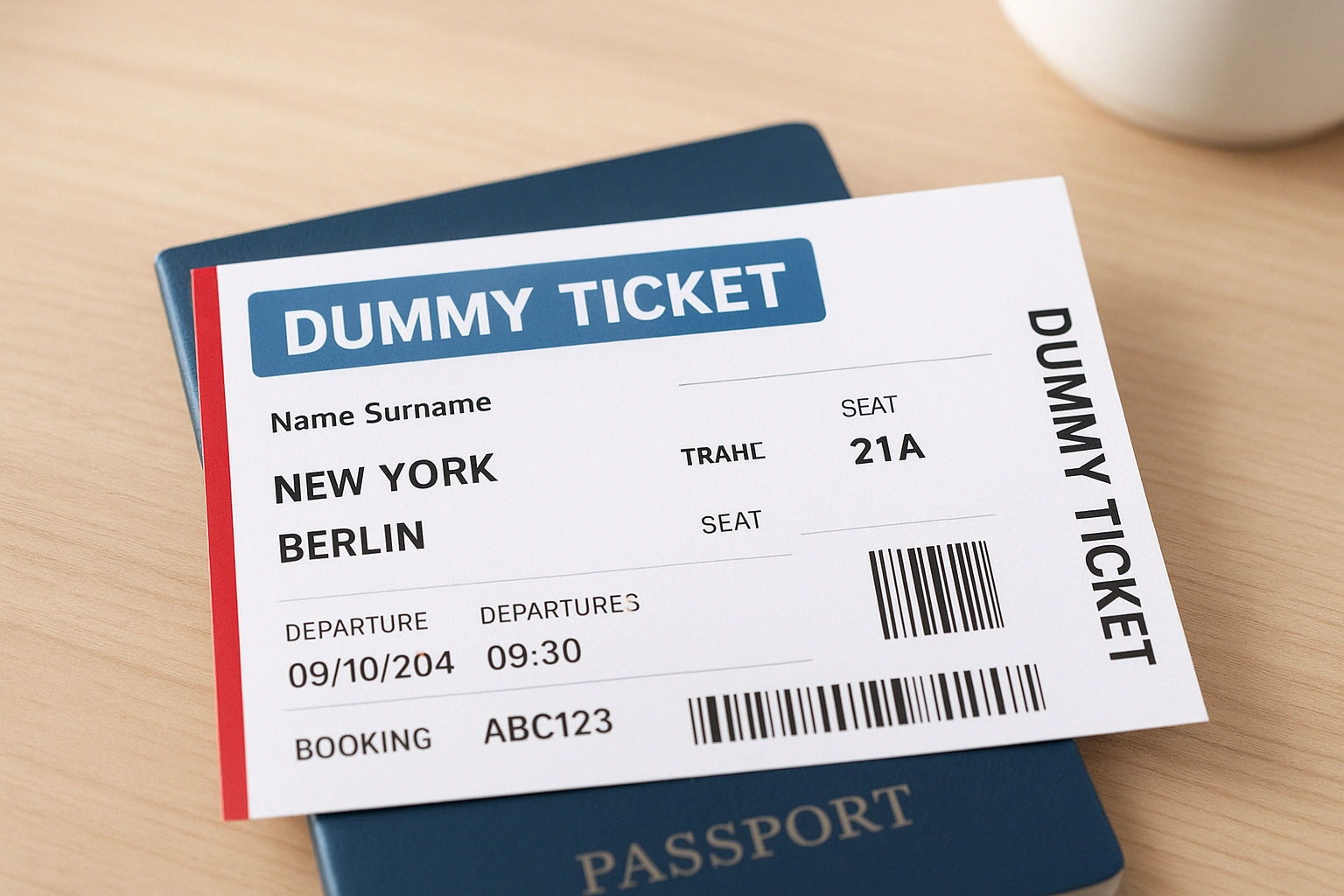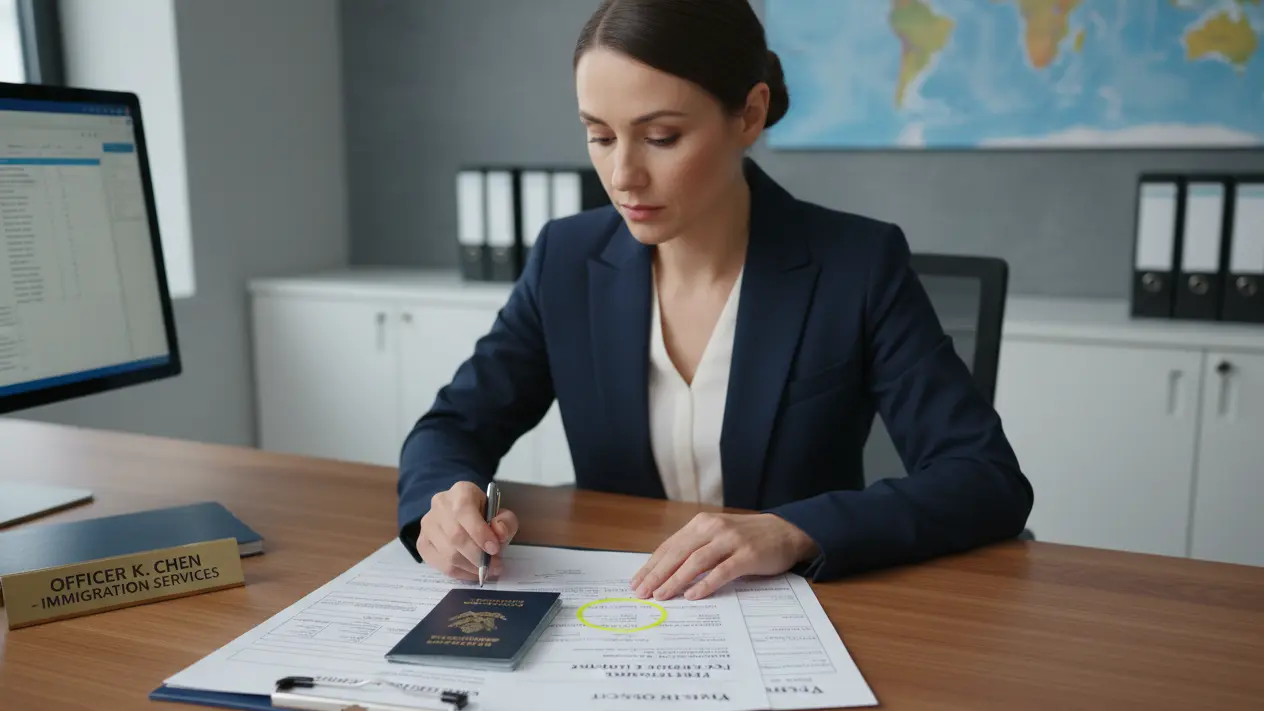UAE Tourist Visa Requirements: Real Ticket or Dummy Reservation?
Your UAE plan is set. Leave dates, a likely route from Delhi or Mumbai, maybe a quick detour to Muscat or Doha. The only snag is that recurring doubt at the application counter: do you really need a fully paid ticket right now, or will a clean, verifiable dummy ticket do the job? For many Indian travelers, a dummy ticket provides the flexibility needed without upfront costs, ensuring your visa application stays on track.
What the rules say and what processors expect are not always the same. Different channels treat flight proof differently, and timing matters. We’ll walk you through the real-world choices that work, when a reservation is enough, when a paid ticket makes sense, and how to keep your file tight from submission to immigration. You’ll leave with clarity, a plan, and zero wasted rupees. Ready to file today? For more tips, check our FAQ or explore blogs on visa essentials. Learn about our expertise on the About Us page.
No — you do not need to purchase a real flight ticket before applying for a UAE tourist visa. UAE immigration, airlines, and visa-processing centers accept a verifiable flight reservation (dummy ticket with a real PNR) as proof of travel dates. This helps travelers avoid paying for costly non-refundable tickets before visa approval. Trusted providers like BookForVisa.com issue instant, embassy-ready PNR reservations that meet UAE immigration requirements and reduce rejection risks caused by missing or inconsistent travel proof.
Last updated: November 2025 — verified with UAE ICP, GDRFA, and airline entry documentation rules.
Table of Contents
Need quick answers? Our FAQ covers common pitfalls, while blogs dive deeper into visa strategies.
Required On Paper, Expected In Practice: Cutting Through The Noise In India
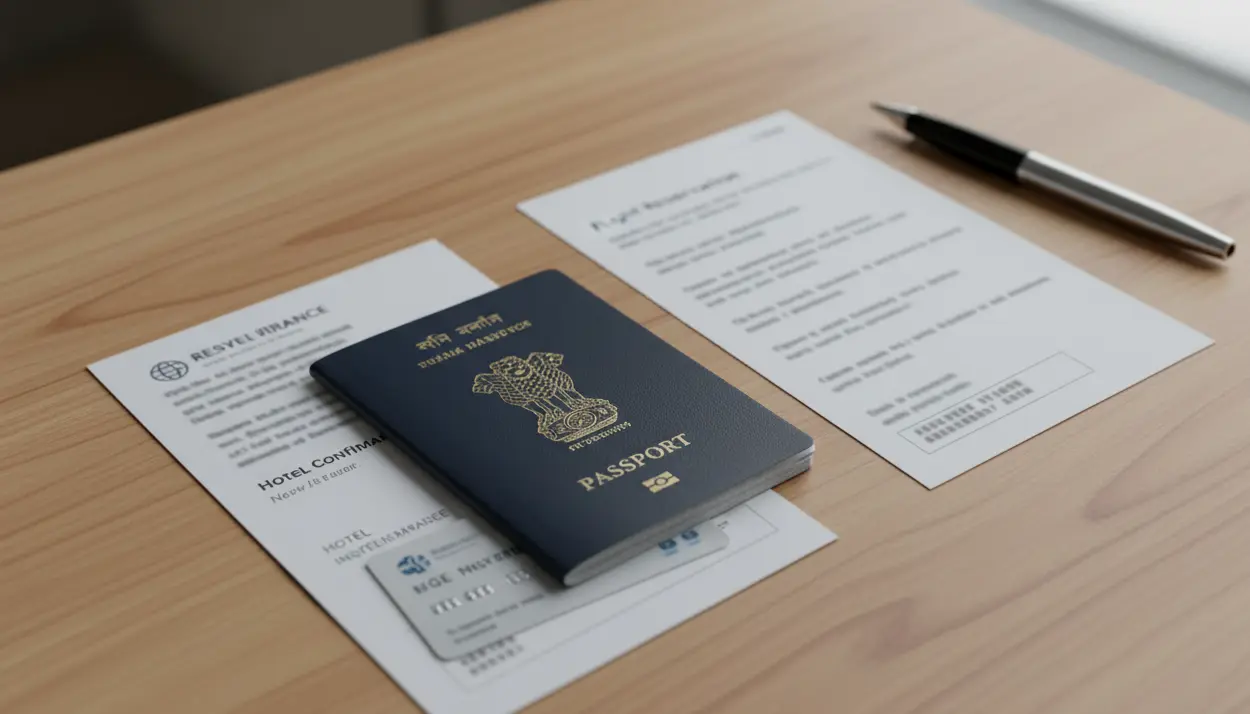
You want a simple answer before you spend a single rupee. The rules say one thing, front desks say another, and friends tell you their version over chai. Let’s separate clarity from chatter so you can make the right move for your UAE tourist visa.
We will start with what is actually required, then map how checklists are applied in India. From there, you will know when a reservation works, when a paid ticket helps, and how to avoid the usual traps. Need a verifiable PNR for your visa? Book a dummy ticket and get it instantly. For official guidelines, see Schengen Visa Info on travel proofs.
Separate Law From Practice
There are two layers you deal with.
Layer one: eligibility rules. This is the high-level requirement. It is about your purpose, stay length, and the fact that you will exit the UAE. It rarely says you must purchase a non-refundable ticket before your visa is granted.
Layer two: document checklists. This is how staff verify your exit plan. They often ask for flight details that are verifiable and aligned with your hotel and insurance. Some counters prefer a paid ticket. Many accept a valid reservation that can be checked.
The confusion begins when these layers get mixed. A checklist item is treated like a law, and applicants panic-buy fares. You do not need to. You only need to provide proof that your exit plan is credible and consistent.
Why Staff Ask For Onward Or Return Proof
From the processor’s view, your itinerary should make sense. They check for:
-
Plausibility. Dates are realistic. No impossible connections. No unexplained gaps.
-
Consistency. Flights match hotel check-in and check-out. Insurance dates cover the whole stay.
-
Verifiability. A locator that can be checked. A reservation that is still valid. Names that match the passport.
-
Exit certainty. A clear return to India, or onward travel to your next country.
If your papers tick these boxes, you are doing exactly what the counter needs. A fully paid ticket is the only way to achieve this.
How Indian Applicants Actually Encounter These Checks
In India, you usually file through an airline-linked channel, a travel agency, a hotel sponsor, or a typing center that submits your pack. Each has a different comfort level.
-
Airline-linked channels. If you are applying with Emirates, Etihad, Air Arabia, or flydubai through their partners, they already see your route data. They may accept a hold or reservation if it is time-bound and verifiable. If you book with them, they will nudge you toward a paid ticket. That is normal.
-
Independent agencies. Many accept a verifiable reservation that shows names, sectors, and dates. They want a clean file. They will ask you to refresh the reservation if it is near expiry.
-
Hotel sponsorships. Hotels care that your stay and flight dates align. If your dates shift, they may request updated flight proof before they send the sponsorship.
-
Typing centers and facilitation counters. They prepare your form and attach documents. A reservation with a live record often works. If it expires, they will ask for a refreshed copy.
Across these routes, the theme is the same. The document must be real, current, and consistent.
When A Confirmed Ticket Is Not Mandated
There are clear cases where a reservation is enough at filing.
-
Your dates are not fully locked. You are waiting for leave approval or family coordination.
-
You are applying well ahead. Buying now would expose you to fare changes and penalties.
-
You need flexibility for the route or timing. You are choosing between Mumbai and Ahmedabad departures, or considering Abu Dhabi versus Dubai entry.
-
You are risk-aware. You do not want to hold a non-refundable asset before the visa result.
In these cases, a verifiable reservation serves the checklist without the purchase risk. The key is validity. If your file sits for a week, make sure the reservation does not expire mid-process.
When A Fully Paid Ticket Is Sensible
There are also moments when paying up front is the smoother path.
-
Fixed dates around an immovable event. A wedding, a trade show, or school holidays when fares spike.
-
Tight travel window. You have leave for exactly six days. You cannot shift.
-
Sale fares that fit your schedule. You know the route and the timing. The price is too good to pass.
-
You are applying through a channel that insists. Some desks prefer a ticket. Pushing back wastes time. Buying a refundable or flexible fare can bridge the gap.
Treat a paid ticket as a strategy, not a default. If you buy, buy with eyes open on fare rules, change penalties, and refund timelines.
The Immigration Angle You Care About
Visa approval and border control are different stages. You may apply with a reservation and be approved. At immigration, the officer can still ask to see a current, active itinerary that matches your visa dates.
This is not a contradiction. It is a simple safeguard. You promised an exit plan at filing. On arrival, you confirm it is still true.
Prepare for this.
-
Carry updated bookings. If you changed dates after approval, bring the new reservation or ticket.
-
Keep the story consistent. Flights, hotel, and insurance should tell one timeline.
-
Avoid near-expired holds. You do not want a check that leads to a blank screen.
Do this, and the airport experience is routine.
Myths That Keep Circulating In India
Let’s clear the most common ones.
-
“Every UAE visa demands a fully paid ticket.” Not accurate. Many channels accept verifiable reservations upon filing. The demand tends to surface when files are inconsistent or staff do not want the risk of chasing expired holds.
-
“A screenshot is enough.” Not always. If it cannot be verified, it can be rejected. A live PNR or a checkable record is stronger.
-
“Any reservation validity works.” Expired holds are a fast way to get a request for updated documents. Keep validity in mind.
-
“Immigration never checks return.” Sometimes they do, especially for first-time flyers, long stays, or unusual routing.
-
“Changing dates after approval is a problem.” It is not, as long as you keep everything aligned and carry the updated proof.
Focus on verifiability and consistency. Myths fade when the file speaks clearly.
The Indian Reality Of Fare Risk
India to the UAE is a busy corridor. Prices move with school breaks, long weekends, expos, and public holidays. If you buy too early and your visa takes longer, you face change fees. If you buy too late, you pay a surge.
Your goal is to manage this curve.
-
If travel is within 7 to 14 days. A reservation can hold your place while the file moves, then you pay once the outcome is in.
-
If you have 3 to 6 weeks. Consider a reservation during submission, watch fares, and purchase after approval within a 24 to 72-hour window.
-
If you apply months out. Reservations give flexibility. Paid tickets are risky unless fully refundable or tied to a specific event.
Plan the documentation around the real fare cycle, not the rumor cycle.
How To Keep Your File Credible Without Overpaying
You want to be accepted on the first pass. You also want to avoid unnecessary spending. Build toward both.
-
Make the dates line up. Flights, hotel vouchers, and insurance must match. If you change one, update the others.
-
Use verifiable documents. A live record beats a PDF that cannot be checked. If staff can validate it, you save time.
-
Watch the reservation lifespan. Some hold the last days. The last two weeks. Time your submission so nothing expires mid-review.
-
Fix name formats. Use the passport name exactly. Middle names and spacing matter.
-
Keep a tidy folder. Passports, photos, visa forms, flight proof, hotel proof, insurance, and sponsor letters. Soft copies and a print set.
These habits keep the process predictable.
A Simple Decision Path You Can Trust
Use this quick logic to choose your approach.
-
What does your channel accept? If the airline, agency, hotel sponsor, or typing center accepts a verifiable reservation, use it while your dates are fluid.
-
How fixed are your dates? If the dates are set by an external event, a paid or flexible fare makes sense.
-
How volatile are fares on your route? If prices swing fast near your window, delay payment until approval, but keep a reservation active.
-
What is your risk tolerance? If change fees cause stress, use reservations or flexible tickets until you are sure.
-
What will immigration ask? Assume they can ask for a current itinerary. Be ready with updated proof, even if your application used a reservation.
Follow this path and you will meet the checklist, protect your money, and avoid last-minute scrambles.
Closing The Gap Between Rules And Reality
On paper, you prove that you will leave the UAE. In practice, you hand over documents that a human must trust. The easiest way to win that trust is to keep your story consistent, keep your proof verifiable, and keep your timing sensible.
If you handle those three, you rarely need to overcommit. You file with confidence, you buy at the right moment, and you walk through immigration with a calm, updated itinerary that matches your stay.
That is how seasoned travelers in India keep their UAE visa process clean, quick, and cost-smart.
How Each Application Route Looks At Your Flights In The Real World
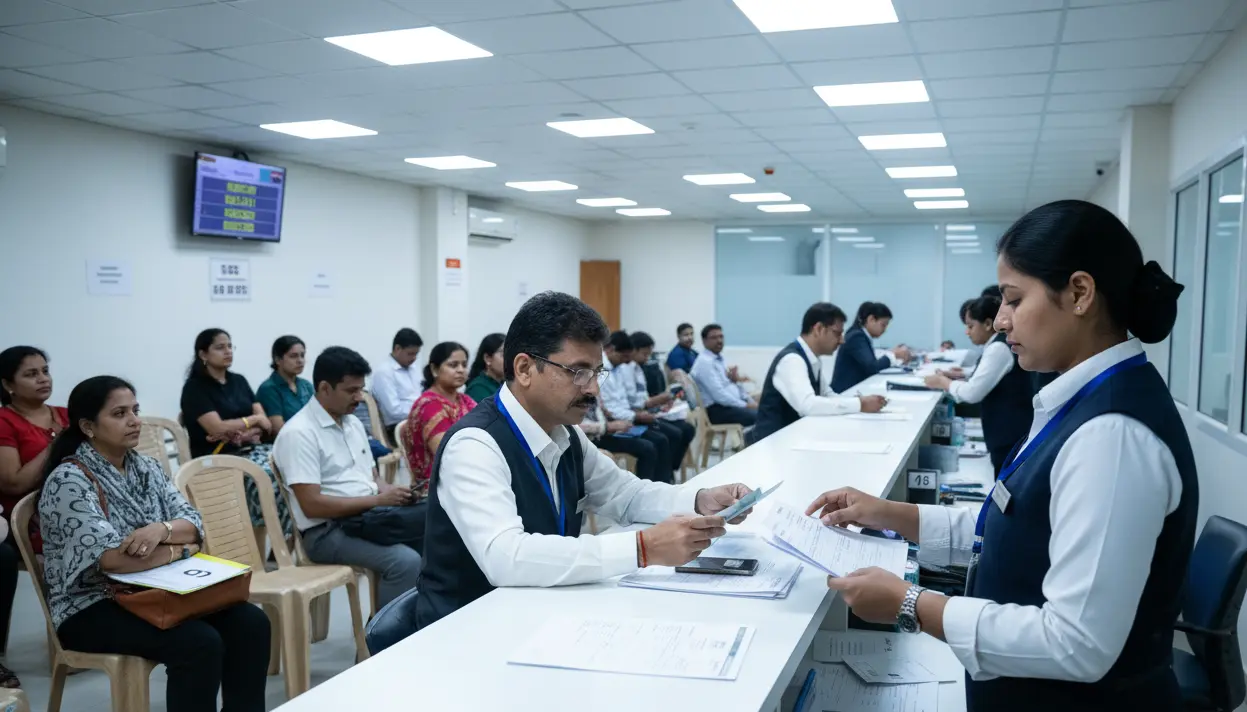
Before you pick a channel, know how that channel thinks. Each route checks flight proof with a slightly different lens. If you understand their habits, you submit once, avoid rework, and keep your wallet safe.
Let’s walk through the routes Indian applicants use most often, and what actually happens at the counter. Keep your dates flexible—use our dummy ticket booking with unlimited changes.
Airline-Linked Channels: What Helps And What Triggers Follow-Ups
When you apply through an airline-linked path, the staff can usually see the route you plan to fly. That visibility changes the conversation. They look for a believable itinerary and a record they can pull up.
Here is what works well.
-
Verifiable holds or reservations: A live locator that shows your name, sectors, and dates. If the airline owns the system, validation is instant.
-
Aligned dates: Your hotel voucher and insurance align with the flight in and out. No stray nights.
-
Plausible timing: Realistic connections, reasonable arrival hours, and no overnight gaps that you cannot explain.
Here is what triggers questions.
-
Expired or near-expiry holds: If your hold dies in 24 hours and the file will move next week, they will ask you to refresh now.
-
Screen captures without verification: If staff cannot validate the record, they treat it as weak proof.
-
Mismatch with hotel or sponsor letter: If your sponsor letter says 7 nights and your flight shows 11, expect a call.
If you plan to buy the same airline later, say so. It signals intent without locking you into a non-refundable fare before approval.
Independent Visa Agencies In India: What They Accept And Why
Independent agencies focus on a clean, defensible file. They are not tied to a single carrier, so they handle a mix of full tickets, refundable fares, and reservations.
What they typically accept.
-
Reservations with live PNRs: The agent can check the record and attach the PDF to your pack.
-
Time-limited airline holds: When the hold is long enough to survive submission, they are comfortable.
-
Refundable or flexible tickets: If you prefer to pay upfront, they document the fare rules to show flexibility.
Why do they sometimes push back?
-
Short validity windows: If the hold ends before your slot at a facilitation center, they will ask for a fresh copy closer to the appointment.
-
Inconsistent dates across documents: Agencies hate resubmissions. They will ask you to fix misaligned hotel and insurance dates before they print anything.
-
Unusual routings: Multi-stop detours that add risk can trigger a request for stronger proof or a simpler routing.
Work with an agency that tells you the refresh plan. Knowing who will update the reservation and when saves time.
Hotel Sponsorships: Keeping Stays And Flights In Sync
When the hotel sponsors your visit, the lens is simple. The hotel wants to see flights that match the booking you hold with them.
What helps.
-
Entry and exit dates that match the stay: If you extend the hotel by two nights, refresh the flight proof to reflect the new checkout.
-
Clear onward plan: If you leave the UAE for Oman or Saudi Arabia, show that onward segment so your stay length makes sense.
-
Insurance that covers the entire period: Hotels often glance at insurance to confirm your timeline.
What causes friction?
-
Floating dates: If you keep moving the check-in without updating the flight proof, the sponsor hesitates.
-
Back-to-back holds: A string of short holds that expire every other day creates extra work for the hotel team and can delay the sponsor letter.
Keep one clean file, then update everything together if you shift dates. Sponsors move faster when they see order.
Typing Centers And VFS-Type Desks: Checklist Mindset And Tips
Typing centers and facilitation desks care about boxes ticked and documents that can pass a quick validation. They do not want to debate fare rules. They want to attach a proof that will not bounce.
What to bring.
-
A reservation that can be checked: A live PNR or a confirmation that opens in the airline system.
-
Dates that match: They compare flights, hotels, and insurance without commentary. If the dates line up, they move on.
-
A reservation that will stay valid through submission: If your appointment is three days away, make sure the hold covers that window.
What to avoid.
-
Old PDFs with new dates typed in: Any sign of alteration leads to delays or refusal.
-
Open-ended itineraries without exit: A clear return or onward plan is non-negotiable at these counters.
If your reservation will expire before the appointment, tell the desk you will refresh on the morning of submission. Arrive with the updated copy.
UAE-Based Sponsor Through Employer Or Family: Expectations And Proof
Employer or family sponsors want assurance that your trip aligns with their letter. They are responsible for your file, so they care about consistency.
Good signals.
-
Flights that mirror the sponsor letter: If the letter states 10 days, the flights show 10 days.
-
Professional documentation: Clean PDFs, uninterrupted validity, and names that match your passport exactly.
-
Onward clarity: If you plan to continue to Europe, attach the onward booking so the sponsor is not questioned about extended stays.
Watch-outs.
-
Frequent date changes without explanation: Sponsors do not like to reissue letters repeatedly.
-
Non-refundable tickets bought too early: If the trip shifts due to sponsor availability, you carry the cost.
Coordinate with your sponsor before you refresh or purchase. Keep them in the loop so their letter and your reservations move together.
City-To-City Variations Across India: What Changes And What Stays The Same
Practices vary across cities. The core checklist remains stable, but the temperature at the desk feels different.
What changes.
-
Appointment availability: Metro centers can be busier, which means longer gaps between booking and submission. You need reservations with longer validity or a plan to refresh.
-
Comfort with reservations: High-volume desks often have clear patterns. If they are used to verifiable PNRs, things move fast. Smaller centers sometimes lean cautious and ask for stronger proof.
What stays the same.
-
Verifiability beats screenshots: Everywhere.
-
Aligned dates win: Everywhere.
-
Expired holds are a problem: Everywhere.
Plan for the local rhythm. If your city’s desk is strict, carry a backup option, such as a refundable fare on the same routing.
When A Desk Pushes For A Paid Ticket: How To Respond Smoothly
Sometimes a counter says paid ticket only. You can still navigate this without overcommitting.
Start with a calm, practical reply.
-
Ask what verification is acceptable: If they accept a live PNR, offer a fresh reservation that stays valid through their processing window.
-
Offer a refundable or flexible fare: If they insist on a ticket, choose a fare that allows changes or refunds with clear terms.
-
Document everything: Print fare rules if you go the refundable route. It shows you are not trying to game the system, only to manage risk.
If you cannot shift the desk, choose the path with the lowest downside. A flexible fare is a safety valve when the policy is firm.
Re-Submissions And Refreshes: Keeping Validity Alive
The most common reason for rework is an expired reservation. Fix this with a simple routine.
-
Check validity windows: Some hold last 48 hours, some for seven days, some for two weeks. Know your type.
-
Count backward from your appointment: Ensure the reservation is valid on the appointment date and at least 24 hours after, in case of delays.
-
Refresh once, not five times: Time your refresh to cover submission and the expected review period. Too many refreshes create version confusion.
If your application is online, set reminders to update the reservation before it lapses. If it is in person, arrive with the latest copy.
Real-World Examples To Make It Concrete
A few typical Indian scenarios show how to choose wisely.
-
Hyderabad to Dubai with a festival weekend: Fares are jumpy. You file with a verifiable reservation that holds for a week, align hotel and insurance, then purchase a ticket within 48 hours of approval.
-
Chennai to Abu Dhabi for a trade visit: Dates are fixed by the host. You buy a flexible fare through the airline-linked channel, attach the receipt and fare rules, and move on.
-
Mumbai to Dubai with onward to Muscat: You show entry to Dubai and onward to Muscat five days later. The hotel sponsor letter matches your UAE stay. Immigration sees a complete path.
These patterns keep your file strong without locking you into a poor fare.
A Quick Cross-Route Checklist You Can Reuse
No matter the route, these habits protect you.
-
Keep everything verifiable: Live PNRs or checkable records beat images.
-
Align all dates: Flights, hotel, insurance, and sponsor letters must match.
-
Respect validity windows: Time holds to survive appointments and reviews.
-
Carry updates for immigration: Even if you applied with a reservation, arrive with a current itinerary.
Follow this, and each route becomes predictable. You meet expectations without overspending, and you glide from submission to decision to boarding with no drama.
Picking The Right Proof: Paid Tickets, Holds, Or Refundable Fares For Indian Travelers
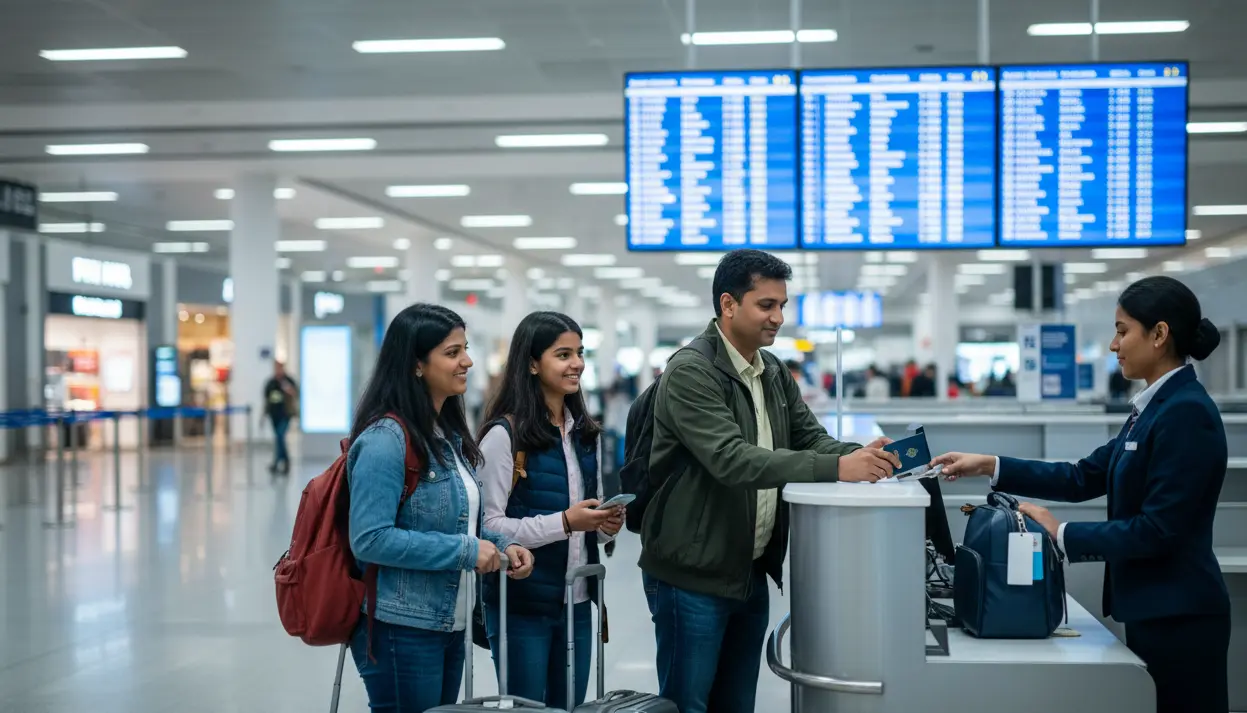
You have options. Each proves your trip in a different way and carries a different financial risk for your UAE visa application. The smart move is to match the document to your timing, fare volatility, and the habits of the channel you are using, while keeping an eye on visa processing time and the actual checklist you will face.
Let’s break it down so you can choose once and avoid unnecessary costs. Submitting at VFS soon? Book a dummy ticket that matches your hotel and insurance. 👉 Order your dummy ticket today
Fully Paid Non-Refundable Tickets: Certainty With Strings Attached
Sometimes a paid ticket is the cleanest path. It settles the “is this real” question in one move. It also locks you to a fare with rules you cannot ignore, which matters if you are filing a visit visa during a busy UAE holiday period or juggling business meetings.
When it works best:
-
Fixed dates. You are traveling for a wedding, a trade show, or a school holiday block that will not shift, and you want flight tickets that match your hotel plan.
-
Great timing. The fare fits your schedule and is unusually low for the route, especially on carriers like Emirates Airlines.
-
Channel insists. Your counter clearly requires a ticket, and negotiating will waste time for your visa application.
What to watch:
-
Change fees. India–UAE non-refundable fares often charge for date changes. Taxes may be re-collected at new rates, and the date mentioned on all documents must stay consistent.
-
No-shows. Miss a segment, and the rest can cancel. Reinstatement costs more than people expect.
-
Name errors. A tiny mismatch with your original passport can mean a new ticket. Always match the passport format and ensure machine-readable passport details are copied exactly.
How to reduce downside:
-
Pick flights with multiple daily frequencies. If you must change, a busy route offers more rebooking options, including on Etihad Airways, where schedules are dense.
-
Avoid split tickets. Two separate tickets double the disruption risk if you miss a connection on the onward journey.
-
Keep proof handy. Save the e-ticket receipt, fare rules, and the airline app boarding pass for easy retrieval, plus a scan of any confirmed hotel reservation that aligns.
Use non-refundable tickets when certainty beats flexibility and you have zero doubt about your dates.
Airline Holds And Temporary Reservations: Proof Without Overcommitment
Holds and time-limited reservations give you breathing room. They let you submit a file that looks complete while you wait for approval or finalize leave, and they work well when entry validity and stay validity may shift a little.
When it shines:
-
You file this week, travel next month. A hold proves intent now without locking money, and it supports a multiple-entry plan if your type of visa allows it.
-
You have moving parts. Family calendars, sponsor dates, or hotel availability are still settling, so a hotel reservation may move by a night or two.
-
You need to pass a strict checklist. The counter accepts verifiable reservations that show your exit plan and clear entry visa dates.
What to track:
-
Validity window. Holds can last 24 to 72 hours, 7 days, or even 14 days, depending on the source. Know your validity period.
-
Auto-cancel. Once it lapses, the PNR may vanish. Submitting an expired hold wastes everyone’s time, especially if your center processes files excluding Saturday.
-
Version control. If you refresh often, keep only the latest copy in your file; some sources allow a hold to be extended thrice.
How to time it:
-
Count back from submission. Make sure the reservation is valid on the appointment day and at least one day after, so processing times do not catch you out.
-
Refresh once, not repeatedly. One well-timed refresh avoids confusion across documents.
-
Align all dates before you refresh. Update hotel and insurance first. Then refresh flights so everything matches the onward journey.
Holds are the best friend of flexible plans. Manage the timer, and they deliver exactly what the desk wants to see.
Refundable Or Flexible Fares: Pay More To Buy Options
Refundable and semi-flex fares trade higher price for control. They are useful when a desk insists on tickets, but your dates are still moving, or you are watching express visa processing time closely.
Strong use cases:
-
Sponsorship is still fluid. Employer or hotel may shift by a few days, and you want room to adjust without penalty.
-
Risk you cannot absorb. You would rather pay more upfront than carry change penalties later during the overall processing times.
-
Hard channel stance. The counter wants tickets and will not accept reservations.
Due diligence:
-
Read the fare basis. True refundable means cash back to the original method. Some “flex” fares return a voucher or charge cancellation fees that feel like extra visa fees.
-
Check refund timelines. Banks can take several days to post refunds. Plan cash flow accordingly.
-
Confirm change windows. Some fares allow free changes only up to a cut-off before departure.
Smart tactics:
-
Mix cabin types. Sometimes, a flexible outbound and a cheaper inbound balance cost and control.
-
Leverage multi-frequency routes. Flexible fares on busy India–UAE sectors are easier to re-time.
-
Track price drops. If a cheaper fare appears after approval, change to the lower fare when rules allow and reclaim the difference.
Use flexible fares when the desk mandates tickets or when uncertainty is high and you need control.
Full-Service Airlines Versus Low-Cost Carriers: Rules And Realities
Rules shape your risk. Full-service carriers and low-cost carriers treat changes differently, and the difference matters when you buy before approval, whether you hold a single-entry plan or intend multiple entries later under a different visa type.
What to expect on full-service:
-
Change options. More fair families. Better change and refund structures at higher tiers, which helps if your entry validity shifts.
-
Through-checked baggage. Helpful if you plan onward travel within the region on a transit visa.
-
Phone and app support. Easier to manage time-sensitive changes.
What to expect on low-cost:
-
Strict change policies. Lower fare, tighter rules. Changes may cost more than you saved.
-
Ancillary charges. Seats, bags, and meals add up if you rethink plans later.
-
Segment independence. Each leg can carry its own fee exposure.
How to choose:
-
If approval is pending. Favor reservations or flexible fares on full-service carriers. Low cost can be risky if your dates move.
-
If dates are locked. Low cost can be fine for budget control. Buy only after approval to remove change risk.
-
If you need onward proof. Full-service can bundle multi-sector itineraries neatly for immigration review and clear visa requirements.
Match the carrier model to your risk tolerance and the confidence you have in dates.
Reading Fare Rules Without Getting Lost
You do not need to master fare codes. Focus on the parts that affect your wallet and your paperwork while you assemble the documents required for submission.
Look for:
-
Change fee and reissue conditions. Flat fee or fare difference plus fee. Note timing cut-offs that might collide with a visa application form deadline.
-
Refund type. Cash to card, voucher, or non-refundable with partial tax return.
-
No-show penalty. Missing a check-in often increases fees sharply.
-
Name correction policy. Minor fixes may be allowed. Full name changes are usually not.
Quick process:
-
Open the e-ticket receipt or fare rules link while you also review the UAE visa information from your channel.
-
Scan for the headings that mention “Changes,” “Refunds,” and “No-show.”
-
Save a screenshot of the relevant lines with the ticket number visible so your file stays audit-ready.
This keeps you realistic about costs if plans shift.
Timing Purchases Around Visa Milestones
You want your money to move when risk drops. Tie your purchase decisions to events, not to rumors, and consider the applicant’s nationality and eligibility criteria when you choose your lane.
Practical cadence:
-
At submission. Use a verifiable reservation with enough validity. Keep hotel and insurance aligned, and check the UAE visa application portal for any updates.
-
While waiting. Monitor fares and track seat maps. Do not buy unless a sale aligns perfectly with your dates and you accept the risk, especially if your center publishes a specific visa processing time.
-
After approval. Move fast within 24 to 72 hours. Recheck fares at different times of day. Use cards that settle refunds cleanly if you picked a flexible fare.
Extra tip:
-
Set alert bands. Decide on a target fare for your route. If the price drops into the band after approval, book immediately. If it rises, consider alternate timings or nearby airports like Sharjah versus Dubai.
Let the approval reduce uncertainty before you spend.
Keeping Your Story Tight: Dates, Docs, And Consistency
Your application is read as a single story. Small inconsistencies trigger questions. Keep it tight from the start so your file looks like a valid visa pack.
What to align:
-
Arrival and checkout. The flight matches the first hotel night. The flight out matches the last, and any confirmed hotel reservation mirrors the same dates.
-
Insurance window. Coverage starts the day you land and ends the day you leave.
-
Sponsor letter. Days in the letter equal the days in the flights and hotels; families may add additional documents, such as a birth certificate or a marriage certificate, if requested.
Quick fixes:
-
If your hotel shifts. Update flights and insurance the same day. Replace all PDFs in the file and ensure any UAE visa photo remains a colour photograph on a white background if you re-upload.
-
If your flight shifts. Check whether the sponsor letter still matches. If not, request an updated letter before submission and verify any entry validity notes.
A tidy file is the fastest route to approval.
Decision Matrix You Can Use Today
Use this quick selector to avoid second-guessing and to match your visa type to the proof you carry.
-
Dates fixed. Channel accepts tickets only. Buy a flexible or refundable ticket. Attach fare rules and ensure nationals of your category are eligible under the stated type of visa.
-
Dates fluid. Channel accepts verifiable reservations. Use a reservation with a validity window that covers submission. Refresh once just before your slot, and keep the visa application on track.
-
Dates fixed. Channel accepts reservations. Use a reservation to file. Buy after visa approval to avoid no-show risk; check stay validity if the duration changes.
-
Mixed family itineraries. Anchor the group on the most constrained traveler. Use reservations for everyone until all leaves and school dates are locked, and keep the nationality details consistent.
You can adapt this matrix to any India–UAE city pair and any sponsor type.
Common Mistakes And Simple Ways To Avoid Them
A few errors keep repeating. Skip them, and your process becomes easy.
-
Buying too soon. Paying before approval with rigid fares creates stress. Use reservations first while the visa application is being processed.
-
Letting holds expire. Set reminders. Refresh once, timed to your submission.
-
Mismatched names. Copy the passport name exactly into every booking and form; many centers want at least six months' validity on the passport.
-
Ignoring connection times. Pick realistic layovers if you route via third countries; a 90-day remark on stay length does not excuse an impossible transfer.
-
Forgetting immigration. Even if you filed with a reservation, carry a current itinerary when you fly, and keep a note of any residence permit if you are returning residents.
Small habits prevent big delays.
Match Proof To Risk, Then Move With Confidence
Each option has a place. Paid tickets deliver certainty but tie you to rules. Holds protect your wallet while your file moves. Flexible fares cost more but return control when a desk insists on tickets. Please note that some channels may ask for additional documents based on the applicant’s nationality, such as a valid tenancy contract from a UAE sponsor, a residence permit issued copy, or guidance for sponsor unaccompanied minors and unaccompanied minors. If you complete the visa application form correctly and keep dates consistent with entry validity and duration, you stay eligible, and your file reads clean.
Choose the option that matches your timing, your tolerance for change fees, and your channel’s expectations. Keep documents aligned. Track the entry visa details and the validity period. Buy only when the risk drops—and your trip stays simple from approval to boarding for all nationals in your party.
Verifiable Reservations That Work: Where They Shine And How To Use Them Right
You want your file to pass on the first try without locking money too early. A verifiable flight reservation does exactly that when used with care. The key is choosing the right moment and keeping every supporting document in sync.
Let’s walk through when this option is your best move, how processors check it, and the simple routines that keep everything valid and credible. Avoid risky non-refundable fares with a quick dummy ticket booking.
When A Verifiable Reservation Is The Smart Play
There are clear situations where a checkable reservation is your best friend.
-
Dates are still moving. HR is finalizing leave, or a family event may shift a day or two. A reservation shows intent while you wait.
-
Processing timelines are uncertain. Appointments and reviews can slip. You protect yourself from change fees.
-
Fare volatility is high. Long weekends and festival weeks can yo-yo prices. You avoid buying at the wrong time.
-
Multi-city planning. You may enter via Dubai and exit via Abu Dhabi, or continue to Muscat. A reservation helps you model the route.
-
The desk accepts reservations. If your route’s channel accepts verifiable proof at filing, take the flexibility.
Use a reservation when you need credibility without commitment. That balance keeps stress low and options open.
What “Verifiable” Means To People Who Check Documents
Processors are not looking for pretty PDFs. They are looking for proof they can validate quickly.
-
Live record. A locator that opens in the airline or GDS and shows your name, sectors, and dates.
-
Consistency. Details match the passport and the application form character for character.
-
Time validity. The reservation is still active on submission day and for a reasonable buffer after.
-
Clarity. No strike-throughs, no overlaps, no ambiguous city codes. India–UAE pairs like BOM–DXB or MAA–AUH should be unambiguous.
If staff can pull the record, see your itinerary, and confirm dates that align with your stay, you pass their test.
Getting The Validity Window Right The First Time
Great reservations fail when they expire mid-process. Solve this with simple timing.
-
Know the lifespan. Some reservations live for 48 hours. Others for 7 or 14 days. Note the exact expiry.
-
Work backward from the appointment. Ensure the reservation is valid on submission day and at least 24 hours after.
-
Plan a single refresh. Refresh once just before submission so the copy in your file is current throughout review.
-
Label versions. Keep a single “current” PDF in your folder and archive older versions in a separate subfolder to avoid mix-ups.
A one-time, well-timed refresh is better than five small updates that confuse the file.
Aligning Flights, Hotels, And Insurance So Your Story Clicks
Your file is read as one story. Every date should connect smoothly.
-
Arrival lines up with check-in. The first hotel night matches the day you land.
-
Departure lines up with checkout. Your flight out is the same day your stay ends.
-
Insurance covers the full window. The policy starts on arrival and ends on departure. Add a one-day buffer if you like.
-
Sponsor letter matches. If a hotel or employer sponsors the stay, the days match the flights.
If you adjust one part, update the others the same day. Replace all PDFs in your folder so no one sees mismatched dates.
Avoiding The Pitfalls That Trip Up Good Applications
Most problems come from avoidable errors. Keep these out of your file.
-
Expired holds. Staff open the record and find nothing. This leads to a request for updated proof.
-
Unverifiable screenshots. If the locator cannot be checked, the document loses value.
-
Name mismatches. Extra spaces, missing middle names, or wrong sequences cause friction. Mirror the passport format exactly.
-
Unrealistic connections. A tight turn via a third country can look weak. Pick sensible layovers.
-
Stale itineraries. If dates shift and you do not refresh flights, hotels, and insurance together, the file looks sloppy.
Tidy, verifiable, and current beats everything else.
How To Use Reservations On Common India–UAE Routes
Different city pairs behave differently during peak periods. Plan for the pattern you face.
-
Delhi or Mumbai to Dubai. Heavy frequency and frequent sales. Use a 7–14 day reservation for submission. Buy within 24–72 hours after approval when fares settle.
-
Chennai to Abu Dhabi. Corporate peaks can spike pricing. A reservation protects you while sponsorship letters are finalized.
-
Kochi to Sharjah. Family travel clusters around school breaks. Keep flexibility until the final school schedule is confirmed.
-
Hyderabad to Dubai with onward Muscat. Show both segments. Immigration likes seeing the onward plan if you exit the UAE within a week.
The reservation buys time across all these patterns, as long as you keep validity in view.
Solo Travelers And First-Time Flyers: Extra Care That Pays Off
Verifiable reservations help, but your overall profile also matters. Strengthen your file with a few extras.
-
Document stability. Employment letters, leave approvals, or strong ties in India reduce questions.
-
Clear purpose. Short, consistent stays with matching hotel and insurance suggest a genuine trip.
-
Return options. If your outbound date is firm but the return may shift, note a realistic window and keep the reservation updated.
For first-time travelers, polished documents create confidence at the desk and at immigration.
Using Reservations For Multi-Country Plans Without Confusion
If you are visiting UAE, then continuing to Oman, Saudi Arabia, or further west, build a simple, visible path.
-
Show the chain. Entry into the UAE and the onward segment. Dates line up with hotel stays.
-
Keep buffers. Allow time between flights that matches real-world connection times.
-
Document logic. If you stay in the UAE for five nights and then fly to Muscat, your insurance and hotel reflect that exact flow.
A clear chain answers the officer’s main question. How do you exit, and when?
A Reliable Option When You Need A Verifiable Reservation
If a verifiable reservation fits your plan, you can use BookForVisa.com for a PNR-checkable flight reservation designed for visa files. You receive a ready-to-submit PDF instantly, priced at $15 (≈₹1,300). You can change dates unlimited times, and the PNR is built to be verified by staff. Use this only where your channel accepts reservations. Buy the real ticket after your visa is approved and your dates are final.
Refresh Routines For Online Submissions And In-Person Appointments
Two workflows keep validity intact depending on how you submit.
-
Online submission. Upload the reservation on the filing day. Set a reminder for the expected review window. If the decision takes longer, refresh the reservation and upload the new PDF with a short note through the portal if allowed.
-
In-person appointment. Print the latest reservation on the morning of your slot. Carry a soft copy on your phone and one extra print. If the center delays by a day, refresh again before you return.
One scheduled refresh beats emergency scrambles.
Handling Desk Pushback Without Losing Flexibility
If a counter insists on tickets, keep the door open to control.
-
Offer a fresh, verifiable reservation first. Confirm that the PNR can be checked. Many desks accept once they see a live record.
-
If they hold the line, switch to flexible. Book a refundable or change-friendly fare and attach the fare rules. You meet their standard while protecting your money.
-
Document alignment. Replace hotels and insurance if dates shift to match the new ticket.
Stay calm, show options, and move forward with the least downside.
After Approval, Convert The Reservation To A Real Ticket Smoothly
Approval is the moment to lock plans at the best price without surprises.
-
Reprice the route. Check fares at a few times of day. Look at nearby airports like Sharjah if Dubai spikes.
-
Book within 24–72 hours. Most price dips appear in that window. Secure seats while availability is good.
-
Sync everything. If final flight times differ slightly from the reservation, adjust hotel checkout and insurance to match. Replace all PDFs in your travel folder.
Carry the final e-ticket, hotel voucher, and insurance certificate when you travel. Keep a soft copy set in email and on your phone.
Checklist You Can Reuse Anytime
Print or save this for future trips.
-
Choose wisely. Use a verifiable reservation if dates are fluid and your channel accepts it.
-
Track the timer. Know the reservation’s exact expiry. Plan one refresh around submission.
-
Align documents. Flights, hotel, insurance, and sponsor letters all match.
-
Keep names exact. Copy the passport format into every field.
-
Prepare for immigration. Even if you filed with a reservation, carry a current itinerary when you fly.
Follow these steps, and your reservation does what it should. It proves your plan, keeps your wallet safe, and sets you up to book the real ticket at the right moment.
When Plans Get Messy: Real-World Indian Scenarios And How To Sail Through
Your timeline is tight. Your route is not simple. Or your profile could trigger extra questions. That is normal. We build around it with clean proof, smart timing, and documents that tell one story from start to finish.
Here is how we handle the situations Indian travelers face most often, without losing money or time. Last-minute slot opened? Book a dummy ticket now and upload the PDF.
Last-Minute Departures From India Without Chaos
Rushed trips are common. A client meeting in Dubai pops up. A family event gets confirmed late. You do not need to panic-buy the wrong fare.
Start with control.
-
Lock a verifiable reservation first. It satisfies the checklist now while you sort stays and insurance.
-
Pick routes with frequent flights. Delhi, Mumbai, and Hyderabad to Dubai or Abu Dhabi give more rebooking options if timing moves.
-
Hold hotel and insurance together. Create short, aligned documents that mirror the flight dates.
Work backward from your earliest possible departure.
- If you plan to leave within 5 to 7 days, choose a reservation that stays valid through submission and at least a day after.
- Refresh once, on the morning of the appointment or online filing.
- After approval, buy in the first 24 to 48 hours. Scan nearby airports like Sharjah if Dubai prices spike.
Avoid the traps.
-
Do not mix old and new PDFs. Replace everything together when dates change.
-
Do not accept impossible connections. A rushed plan must still be realistic, or it invites questions.
Move fast, but keep the file tidy. That is how last-minute trips pass cleanly.
Multi-Country Plans: Show A Clear Path In And Out
You may enter the UAE, continue to Oman, then return to India. Or you may fly into Abu Dhabi and exit from Dubai. The key is a visible chain.
Build the chain.
-
UAE entry segment. Match the date to your first hotel night.
-
Onward or return segment. Show the exit from the UAE or the next country with dates that align.
-
Insurance split or extended window. Either extend one policy across all stops or issue two aligned policies. The officer should see coverage that matches the travel story.
Keep margins healthy.
-
Layover time. Use realistic transfers if you route via Doha or Bahrain. Short turns look risky.
-
City code clarity. Use clear India–UAE pairs like MAA–AUH and DXB–BOM. Avoid exotic detours unless necessary.
For ground crossings, such as UAE to Oman by road, attach the onward flight from Muscat and keep hotel dates aligned on both sides. The story remains visible even without an air segment between.
Solo Travelers And First-Time Flyers: Build Confidence With Documents
Solo and first-time flyers get more questions because officers lack prior travel history to lean on. We fix that with clarity and strong ties to home.
Strengthen the file.
-
Employment stability. Add a leave letter with the employer contact. Keep the dates identical to your flights.
-
Purpose clarity. A concise travel note helps. Short stay, tourist purpose, daily outline if asked.
-
Financial coherence. Bank statements that match the scale of the trip. No last-minute deposits that look staged.
Flight-proof tactics.
-
Use verifiable reservations for filing. Keep dates moderate. Six to eight nights look practical.
-
After approval, buy tickets that match the plan. Carry the final e-ticket to immigration.
Small, tidy files win trust. That is the goal for solo and first-time travelers.
Families, Minors, And Staggered Itineraries: Keep Everyone In Sync
Family plans carry extra details. Names, guardianship, and school calendars must align with flights and stays.
Build a family-first structure.
-
One master timeline. Arrival and departure dates that fit all travelers.
-
Aligned documents per traveler. Each passport, each ticket or reservation, each insurance policy in a labeled folder.
-
Parental consent. If one parent is not traveling, carry a notarized consent and ID copy. Dates and names must match the flights.
Avoid pitfalls.
-
Mixed carriers with mismatched schedules. Keep everyone on the same flights or close alternatives within hours, not days.
-
Unclear accommodation. Family rooms or adjoining bookings should reflect the headcount. Officers notice when the hotel capacity does not match.
Give minors extra care at the desk. Clean paperwork removes friction.
Past Rejections Or Overstay History: Rebuild With Transparency
If you have a prior refusal or a status issue, the solution is not more papers. It is stronger, verifiable alignment, and a credible plan.
Reinforce the story.
-
Use a clean, verifiable reservation. Show a reasonable stay length with an obvious exit.
-
Explain changes in timing. If dates shifted from a previous application, reflect that across the hotel and insurance, too.
-
Remove ambiguity. No overlapping nights. No gaps that suggest unplanned stays.
If asked, be factual about the past and clear about the improvements. A coherent file does more work than a long explanation.
Peak Seasons And Price Surges: Protect Budget And Validity
India–UAE fares jump during school holidays, long weekends, and big events. You can still avoid paying at the worst moment.
Plan by season.
-
Six to eight weeks out. File with a verifiable reservation. Do not buy unless a fare aligns with your target band and you accept the risk.
-
Two to three weeks out. Watch fares daily. After approval, move within 24 to 72 hours.
-
Inside ten days. Reservations are essential. Lock tickets as soon as your visa lands.
Tactics that help.
-
Fly into one city, out of another. BOM–SHJ inbound and DXB–BOM outbound sometimes price better than DXB–DXB.
-
Use midweek departures. Tuesday or Wednesday flights often avoid the weekend spike.
-
Check late-night departures. India–UAE night flights can be better priced and still practical.
Seasonal planning turns volatility into savings.
Insurance, Transfers, And Layovers: Look Practical, Not Perfect
Perfect schedules are not required. Practical ones are. Officers look for plans that a real traveler can execute.
Make it realistic.
-
Buffer hours. India–GCC connections need breathing room. Build two to three hours minimum if you route via a third country.
-
Arrival timing. Late-night arrivals are common in the UAE. Ensure hotel check-in reflects this. A very late arrival plus a morning checkout can look odd if not explained by a short business stop.
-
Checked baggage logic. If you split carriers, verify whether bags are through-checked. If not, avoid tight turns.
Align the reservation or ticket to the real flow of the trip. Practical beats theoretical.
On-The-Ground Proof: What To Carry Even If You Filed With A Reservation
Immigration can ask for updated proof on arrival. Prepare once, and you are set.
Carry a compact kit.
-
Current itinerary. Either the final e-ticket or an active reservation that matches your visa window.
-
Hotel voucher. Dates that match the flight story. Family bookings show the right headcount.
-
Insurance certificate. Coverage spans the full stay and includes your arrival day.
-
Sponsor documents, if any. A clear copy with matching dates.
Keep digital copies on your phone and a print set in your bag. Quick access lowers stress.
Sample Playbooks You Can Copy And Adapt
Sometimes a concrete pattern helps you decide fast. Use these as templates and tweak the dates.
Playbook A: Corporate trip confirmed late
-
Verifiable reservation for BOM–DXB return, 6 nights.
-
Employer letter with exact dates and contact.
-
Hotel held with a corporate rate. Insurance for 7 days.
-
File now. Refresh the reservation on submission morning.
-
After approval, buy a flexible outbound and a cheaper inbound.
Playbook B: Family short break during school holidays
-
Reservations for HYD–AUH for four travelers, 5 nights.
-
Family room booking that matches headcount. Insurance per traveler.
-
School calendar attached if needed.
-
After approval, watch fares for 48 hours. Book the same carrier for everyone.
Playbook C: UAE plus Oman loop
-
Reservation for MAA–AUH inbound, AUH–MCT onward, MCT–MAA return.
-
Two hotel vouchers. One for the UAE, one for Muscat. Insurance covering both segments.
-
Submit with the full chain visible. Buy tickets after visa approval, keeping the sequence intact.
Each playbook keeps verifiability, alignment, and timing front and center.
Quick Mistake Sweep Before You Submit
Spend five minutes on this check. It saves days later.
-
Names match passport formatting on flights, hotels, and forms.
-
Dates align across all documents. No overlaps or empty gaps.
-
Reservation validity covers the submission and expected review window.
-
The insurance window matches the arrival and departure. One-day buffer is fine.
-
One current version of every PDF in your folder. Old versions are archived separately.
If these pass, your file reads like a seasoned traveler planned it.
The Outcome We Aim For In Every Tricky Scenario
Complex plans do not need complex fixes. You need clear, verifiable proof, aligned dates, and timing that respects validity windows. Use reservations when the money risk is high. Use flexible tickets when a desk insists. Buy only when uncertainty drops.
Do this, and even tricky itineraries glide from submission to approval to boarding. You look prepared at every counter, and your trip begins the way it should: calm, organized, and on schedule.
Make Your File Bulletproof: Practical India-Focused Steps That Work First Time
You want a smooth path from submission to stamp to boarding. That starts with a file that looks clean, reads clearly, and stays valid from day one to arrival. Use this section as your working playbook.
We will keep it simple, direct, and ready to copy for your own trip.
Start With The Exact Checklist You Will Be Judged Against
Every route has a checklist. Use that document as the source of truth and build backward.
-
Pull the current checklist from your airline channel, sponsor, agency, or typing center. Screenshots from friends do not count.
-
Highlight flight proof requirements and note acceptable forms. If the list says reservation or ticket, you already know your lane.
-
Confirm format rules such as PDF only, passport name format, and whether a live PNR is preferred.
-
Ask about timing for validity. If staff expect the reservation to be active on submission and for 24 hours after, plan your refresh around that window.
Once the checklist is clear, you stop guessing and start assembling.
Map Your Dates So Everything Tells One Story
A visa file is a story told with dates. The story has to make sense at a glance.
-
Anchor on flight dates. Entry and exit create the frame.
-
Lay hotel nights inside the frame. First night equals arrival day. Last night equals departure day.
-
Wrap insurance around the frame. Policy starts on arrival and ends on departure. A one-day buffer is fine.
-
Match sponsor letters to the same number of days. If the letter says 8 nights, your flights and hotels show 8 nights.
If one block moves, move the others on the same day. Replace every PDF so your file never shows mixed timelines.
Lock Names And Numbers Exactly As In The Passport
Tiny mistakes create big delays. Get the identity fields perfect once and reuse them everywhere.
-
Copy the machine-readable line as your reference for spelling and sequence.
-
Use the same format across flights, hotels, insurance, and forms. No extra spaces. No missing middle names.
-
Check the passport number and expiry in every document. A single old digit can send you back to reprint.
Create a small text file with the exact name and number formats. Paste from it into every form to prevent drift.
Choose The Right Flight Proof For Your Timing
Match your proof to your risk. This keeps you compliant without overpaying.
-
Dates still fluid, channel accepts reservations. Use a verifiable reservation with a lifespan that covers submission and at least a day after. Plan one refresh.
-
Channel insists that tickets or dates are fixed. Pick a flexible or refundable fare and save the fare rules in your folder.
-
The sale fare looks perfect, but approval is pending. Only buy if you accept change fees. Otherwise, hold with a reservation, then purchase after approval.
State your plan in one line inside your folder notes so everyone helping you stays aligned.
Control Reservation Lifespan So Nothing Expires Mid-Process
Good reservations fail when they die during review. Avoid that with simple timing.
-
Write the expiry in big text on your reservation PDF filename, such as “BOM-DXB-RES-Valid-Until-14-Feb-23h59.pdf.”
-
Count backward from your appointment or upload moment. Your reservation should remain active through submission and the next business day.
-
Schedule one refresh on the morning of submission. Print and save the new PDF. Archive older versions in a subfolder called “Old.”
-
Avoid serial refreshes across multiple days. Too many versions create confusion and mistakes at the counter.
One clean refresh beats a week of micro-updates.
Keep A Tidy Folder That Anyone Can Understand In Thirty Seconds
Order reduces stress. Use a simple structure and stick to it.
-
01_Passports with scans and photos.
-
02_Flights with current reservation or tickets. Old versions in 02_Flights/Old.
-
03_Hotels with confirmed vouchers.
-
04_Insurance with policy PDFs.
-
05_Sponsor with letters, IDs, or guarantees.
-
06_Extras like leave letters or bank statements.
-
00_Readme text file that lists your itinerary in two lines and notes any refresh dates.
If a stranger can navigate your folder in seconds, the desk will too.
Pressure-Test Your Itinerary Like An Officer Would
Check what they check. Fix what they would flag.
-
Plausibility: No impossible connections. No gaps between hotel checkout and flight out.
-
Consistency: Same dates across flights, hotel, insurance, and sponsor letter.
-
Verifiability: Live PNR or checkable locator. If staff can open it, you are good.
-
Length of stay: Reasonable for tourism. Five to ten nights is common for first-time visitors.
Read your file as a single page in your head. If the story flows, you are ready.
Build A Simple Refresh And Submit Routine
Routines prevent surprises. Create a mini schedule and follow it.
-
Three days before submission: Check reservations, hotel, and insurance dates match. Prepare a refresh if anything will expire.
-
Submission day morning: Refresh the reservation once. Print two copies. Save the PDF with “current” in the filename.
-
After submission: Set a reminder for the expected decision date. If the process runs long, refresh again only when asked or when the validity is near expiry.
-
Decision day: If approved, reprice flights and buy within 24 to 72 hours. Update hotel and insurance if times change.
Write this routine in your Readme so everyone stays on the same page.
Prepare For Immigration Even If You Filed With A Reservation
Approval is not the finish line. Arrival is. Bring current proof to match your story at the border.
-
Carry the final e-ticket or an active reservation if you have not bought yet, and your plan allows it.
-
Pack hotel vouchers that reflect the real headcount and dates.
-
Bring the insurance policy with coverage across your stay.
-
Keep sponsor papers if relevant and ensure dates still align.
Store a soft copy set in your email and a secure cloud folder. Save a print set in your cabin bag.
Handle Last-Minute Shifts Without Breaking The File
Plans move. Your documentation should move with them smoothly.
-
Change one, change all. If the flight shifts, update hotel and insurance the same day. Replace every PDF in your folder.
-
Label the update. Use filenames with the date, such as “DXB-HOTEL-Confirm-24-Mar.”
-
Tell your channel. If an agency or sponsor is involved, share the updated set in one message with a clear “All dates aligned” note.
Small, coordinated changes keep your file credible through turbulence.
Use Money-Smart Timing After Approval
Once the visa lands, your risk drops and your options expand.
-
Watch fares for 24 to 72 hours. Busy India–UAE sectors often show dips at odd hours. Check late evenings and early mornings.
-
Consider alternate airports. DXB, AUH, and SHJ can price differently on the same day. Pick the one that keeps your hotel plan intact.
-
Choose the right mix. If your outbound timing is non-negotiable, pay for flexibility going out and save on the return.
Buy when your plan is firm and the fare fits your target band.
Keep A One-Page Summary You Can Show Anyone
A one-page summary makes life easier at every counter.
-
Traveler details with passport numbers and expiry.
-
Entry and exit flights with dates and locators.
-
Hotel names and addresses with check-in and check-out.
-
Insurance policy number with start and end dates.
-
Sponsor contact if applicable.
Print it, save it as a PDF, and keep it on your phone. It is your quick-reference script.
Common Fixes That Save Days Of Back-And-Forth
These small moves prevent large headaches.
-
Add a buffer day to insurance if your arrival is late at night.
-
Use realistic connection times if routing via a third country.
-
Keep the same city pair across proof unless your plan clearly shows open-jaw travel with logic.
-
Avoid mixed versions of documents in email threads. Always send one consolidated, current set.
Make these your default habits, and your file stops generating questions.
A Reusable Pre-Submission Checklist For Indian Travelers
Copy this and tick each item in five minutes.
-
Checklist confirmed for your specific channel.
-
Flight proof chosen to match timing and risk.
-
Dates aligned across flights, hotels, insurance, and sponsor letters.
-
Reservation validity covers submission plus one day.
-
Names and numbers exactly match the passport.
-
Folder tidy with one current version of each PDF.
-
One-page summary ready in print and digital form.
-
Immigration kit prepared with current itinerary, hotel, insurance, and sponsor docs.
If every line is a yes, your file is ready to move.
The Payoff: First-Pass Approvals And Calm Travel Days
Strong applications are not complicated. They are consistent, verifiable, and timed right. You choose the proof that matches your risk. You keep every date aligned. You refresh once, not five times. Then you buy the real ticket as soon as approval drops and prices make sense.
Follow this playbook, and your UAE plan reads like a pro wrote it. Desks move faster. Decisions land sooner. And you walk through immigration with the quiet confidence that everything in your bag and on your phone tells the same clear story.
UAE Visa Proof That Works, Money You Keep
You don’t always need a paid ticket to win a UAE tourist visa. What you need is a file that’s believable, verifiable, and current. Match your proof to your timing. Keep flights, hotels, and insurance on the same dates. Watch reservation validity so nothing expires during review. After approval, buy the real ticket and carry an updated itinerary for immigration.
Choose the channel, pick the right proof, refresh once, and sync every document. Save one clean set—digital and print. Do this and you protect your budget, avoid rework, and walk through each counter with calm confidence. Smart planning now means a smooth takeoff later. Make your file audit-ready with a clean dummy ticket booking.
What Travelers Are Saying
More Resources
Related Guides
Why Travelers Trust BookForVisa.com
BookForVisa.com has been helping travelers secure verifiable flight reservations since 2019, supporting over 50,000 visa applicants with instant, PNR-checkable dummy tickets. Our 24/7 customer support team ensures secure online payments and immediate PDF delivery. As a registered business specializing exclusively in dummy ticket reservations, BookForVisa.com provides niche expertise you can rely on for a hassle-free process.




